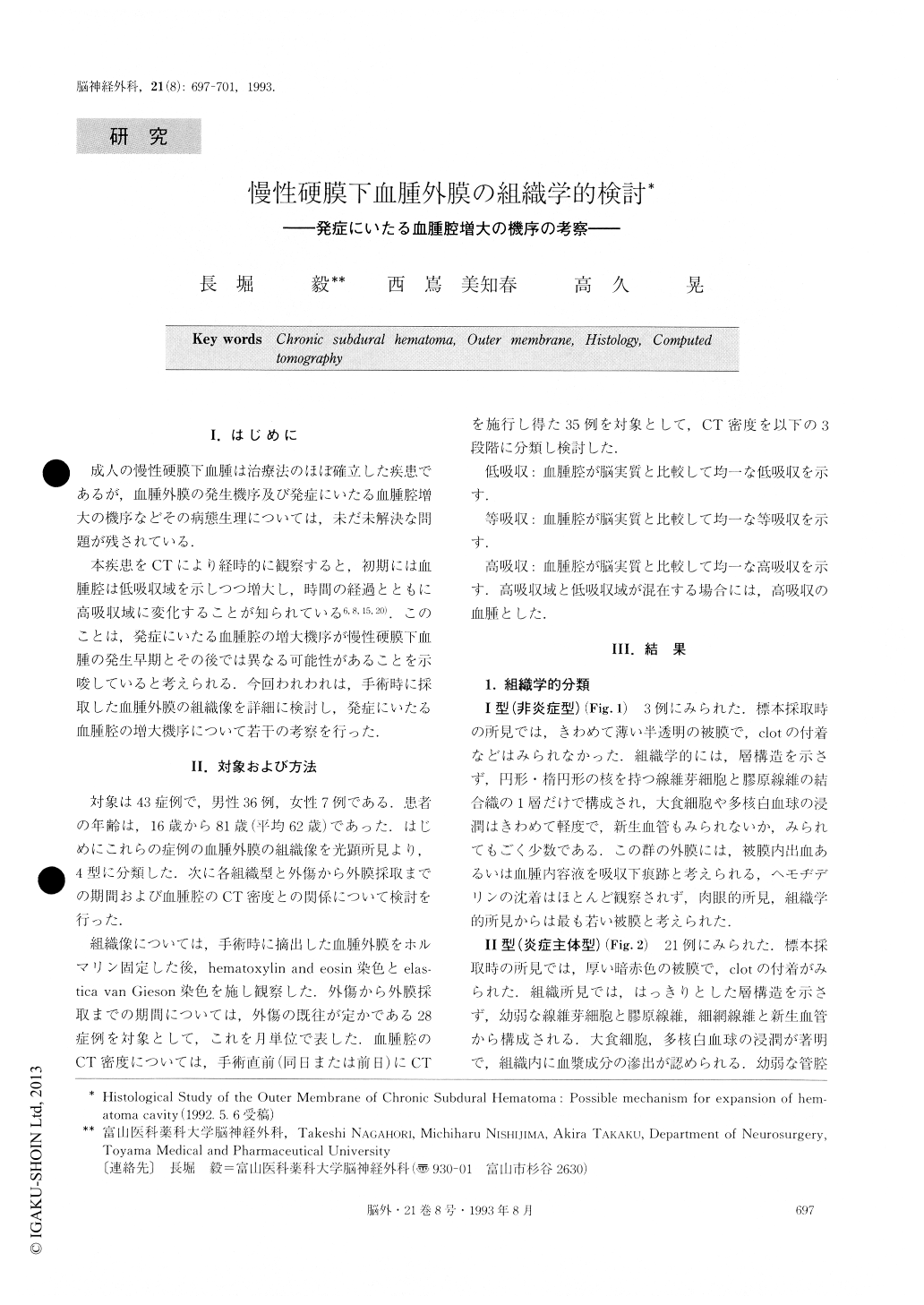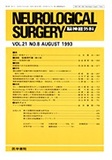Japanese
English
- 有料閲覧
- Abstract 文献概要
- 1ページ目 Look Inside
I.はじめに
成人の慢性硬膜下血腫は治療法のほぼ確立した疾患であるが,血腫外膜の発生機序及び発症にいたる血腫腔増大の機序などその病態生理については,未だ未解決な問題が残されている.
本疾患をCTにより経時的に観察すると,初期には血腫腔は低吸収域を示しつつ増大し,時間の経過とともに高吸収域に変化することが知られている6,8,15,20).このことは,発症にいたる血腫腔の増大機序が慢性硬膜下血腫の発生早期とその後では異なる可能性があることを示唆していると考えられる.今回われわれは,手術時に採取した血腫外膜の組織像を詳細に検討し,発症にいたる血腫腔の増大機序について若干の考察を行った.
Relationship between the histological features of the outer membrane of chronic subdural hematoma and com-puted tomography (CT) findings, and the period from trauma to surgery were studied, and the mechanism of hematoma enlargement was discussed.
This study included 43 patients aged 16 to 84 years. The outer membranes collected during operation were examined by hematoxylin and eosin staining and elastica-van Gieson staining. Histological features were classified into 4 types according to maturity and intensity of the in-flammatory reaction and hemorrhage. Type I: Non-inflammatory membrane. This type of membrane was observed in 3 cases. This membrane, containing imma-ture fibroblasts and collagen fibers, was associated with very slight or sparce cell infiltration and neocapillaries. Type II: Inflammatory membrane. This type of mem-brane was observed in 21 patients. The type, consisting of one layer of immature connective tissue, was associ-ated with marked cell infiltration and vascularization throughout the entire thickness. Type III : Hemorrha-gic-inflammatory membrane. This type of membrane was observed in 14 patients. This type had a structure of 2 or 3 layers, and was associated with capillaries with a large lumen on the side of the dura mater and marked cell infiltration and many thin new vessels on the side of the hematoma cavity. Some patients showed a layer con-sisting of only collagen fibers and fibroblasts between two such layers. In addition, hemorrhage into the mem-brane was often observed. Type IV : Scar-inflammatory membrane. This type of membrane was observed in 4 pa-tients. This type showed inflammatory cell infiltration, neovascularization and hemorrhage in the outer mem-brane of cicatricial tissue.
CT findings of hematoma were classified into three groups of low, iso and high density. Each tissue type was compared with the period from trauma to surgery and CT findings one day before operation. In type II, the mean period was 2.4 months ; it was 4.7 months in type III. This result suggests that the outer membrane changed from type II (marked inflammation) to type III (hemorrhagic tendency). Type I, observed in one patient who had 2.4 months trauma history previous to surgery, was considered the most immature feature from the his-tological viewpoint. Type IV, on the other hand, was considered an aggravation of cicatricial tissue, and the mean period was 2.0-41 months. From the histological fea-tures and the period from trauma to surgery, the outer membrane was considered to have changed from type I to II, III, and IV, in order. The 5 patients who showed low density on CT were all type II. Iso density was observed in 7 patients, 5 with type II, 1 with type III. This result suggests that the frequency of type II (marked inflammatory reaction) or III, is high in the cap-sule of groups with low and iso density, which are consi-dered early CT findings. High density that is indicative of hemorrhage on CT was observed in 20 patients : 3 with type I, 8 with type II, 8 with type III and 4 with type IV. The above results suggested that inflammation is involved in the early stage of hematoma formation, and inflammation and hemorrhage are involved in the subsequent stage of hematoma enlargement.

Copyright © 1993, Igaku-Shoin Ltd. All rights reserved.


